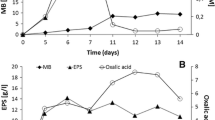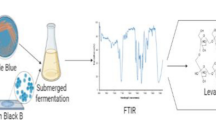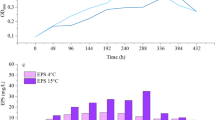Abstract
The polymorphic fungus Aureobasidium pullulans ATHUM 2915, produced significant quantities of extracellular polygalacturonase and polysaccharide when grown, under controlled conditions, in liquid medium with pectin and glucose as carbon sources and nitrogen source as limited factor. Growth, substrate consumption and products formation were simulated by a structured mathematical model, which was compared with the experimental data from batch culture in a chemostat. This model was applied successfully in the study of some essential parameters influenced the process at various pH values.
Similar content being viewed by others
References
Aggelis G, Ratomahenina R, Arnaud A, G1alzy P, Martin P, Peraud J, Pina M & Graille J (1988) Etude de l & #x2019;influence des conditions de culture sur la teneur en acide gamma linolenique de souches de Mucor. Oleagineux 43: 311–317.
Aggelis G & Sourdis J (1997) Prediction of lipid accumulation-degradation in oleaginous microorganisms growing on vegetable oils. Antonie van Leeuwenhoek 72: 159–165
Bermejo MJ, Dominguez JB, Goni FM & Uruburu F (1981a) Influence of carbon and nitrogen sources on the transition from yeast-like cells to chlamydospores in Aureobasidium pullulans. Antonie van Leeuwenhoek 47: 107–119
1—(1981b) Influence of pH on the transition from yeast-like cells to chlamydospores in Aureobasidium pullulans. Antonie van Leeuwenhoek 47: 385–392
Biely P, Heinrichova K & Kruzikova M (1996) Induction and inducers of the pectolytic system in Aureobasidium pullulans. Curr. Microbiol. 33: 6–10
Bluemenkrantz N & Asboe-Hansen G (11973) New methods for quantitative determination of uronic acids. Anal. Biochem. 54: 484–489
Catley BJ (1971a) Role of pH and nitrogen limitation in the elaboration of the extracellular polysaccharide pullulan by Pullularia pullulans. Appl. Microbiol. 22: 650–654
—(1971b) Utilization of carbon sources by Pullularia pullulans for the elaboration of Extracellular polysaccharides Appl. Microbiol. 22: 641–649
Cooper LA & Gadd GM (1984) The induction of mycelial development in Aurebasidium pullulans (IMI 45533) by yeast extract. Antonie van Leeuwenhoek 50: 249–260
Fogarty WM & Kelly CT (1983) Pectic enzymes. In: Fogarty WM(Eds) Microbial Enzymes and Biotechnology (pp 131–182). Applied Science Publishers, London
Fonseca MJV & Said S (1995) Sequential production of pectinases by Penicillium frequentans. World J. Microbiol. Biotechnol. 11: 174–177
Friedrich J, Climerman A & Stiner W(1990) Production of pectolytic enzyme by Aspergillus niger: effect of inoculum size and potassium hexacyanoferrate IItrihydrate. Appl. Microbiol. Biotechnol. 33: 377–381.
Galiotou-Panayotou M, Kapantai M & Kalantzi O (1997) Growth conditions of Aspergillus sp. ATHUM3482 for polygalacturonase production. Appl. Microbiol. and Biotechnol. 47: 425–429
Galiotou-Panayotou M, Rodis P & Kapantai M (1993) Enhanced polygalacturonase production by Aspergillus niger NRRL-364 grown on supplemented citrus. Lett. Appl. Microbiol. 17: 145–148.
Godfrey T & Reichelt J (1983) Industrial Applications. In: Industrial Enzymology, (pp 170–465). Stockton Press, New York
Guterman H & Shabtai YA (1996) A self-tuning vision system for monitoring biotechnological processes. I. Application to production of pullulan by Aureobasidium pullulans. Biotechnol. Bioeng. 51: 501–510
Imanaka T & Aiba S (1977) A kinetic model of catabolite repression in the dual control mechanism in microorganisms. Biotechnol. Bioeng. 19: 757–764
Manachini PL, Parini C & Fortina Mg (1988) Pectic enzymes from Aureobasidium pullulans LV10. Enzyme Microb. Technol. 10: 682–685
McNeil B & Kristiansen B (1990) Temperature effects on polysaccharide formation by Aureobasidium pullulans in stirred tanks. Enzyme Microb. Technol. 12: 521–526
Moresi M, Pertuccioli M & Federici F (1991) Modelling of cyclic fed-batch plus batch polygalacturonase production by Aureobasidium pullulans on raw orange peel. Appl. Microbiol. Biotechnol. 34: 742–748
Mulchandani A, Luong JHT & Leduy A (1988) Batch kinetics of microbial polysaccharide biosynthesis. Biotechnol. Bioeng. 32: 639–646
Nelson N (1944) A photometric adaption of the Somogyi method for the determination of glucose. J. Biol. Chem. 153: 375–380
Parini C, Grazia Fortina M & Manachini PL (1988) Properties of two pectin lyases produced by Aureobasidium pullulans LV 10. J. Appl. Bacteriol. 65: 477–481
Pasari AB, Korus RA, Williams RA & Heimsch RC (1987) Catabolite repression of amylase synthesis in yeast. Biotechnol. Bioeng. 30: 363–367
Reeslev M, Jorgensen BB & Jorgensen OB (1996) Exopolysaccharide production and morphology of Aureobasidium pullulans grown in continuous cultivation with varying ammonium - glucose ratio in the growth medium. J. Biotechnol. 51: 131–135
Ros JM, Saura D, Salmeron MC & Laencina J (1993) Production of pectin enzymes from Rhizopus nigricans cultures with different sources of carbon. Annali di Microbiologia ed Enzimologia. 43: 71–76
Sakai T & Takaoka A (1985) Purification crystalization and some properties of endo-polygalacturonase from Aureobasidium pullulans. Agric. Biol. Chem. 49: 449–458
Seviour RJ, Stasinopoulos SJ, Auer DPF & Gibbs PA (1992) Production of pullulan and other exopolysaccharides by filamentous fungi. Crit. Rev. Biotechnol. 12: 279–298
Simon L, Bouchet B, Caye-Vauglen C & Gallant DJ (1995) Pullulan elaboration and differentiation of the resting forms in it Aureobasidium pullulans. Can. J. Microbiol. 40: 35–45
Somogyi M (1952) Notes on Sugar Determination. J. Biol. Chem. 195: 19–23
Tuttobello R & Mill PJ (1961) The pectic enzymes of Aspergillus niger. Biochem. J. 79: 51–64
Ueda S, Fujita K, Komatsu K & Nakashima Z (1963) Polysaccharide produced by the genus Pullularia. I. Production of polysaccharide by growing cells. Applied Microbiology 11: 211–215
West TP & Redd-Hammer B (1991) Ability of Aureobasidium pullulans to syntesize pullulan upon selected sources of carbon and nitrogen. Microbios 67: 117–124
Ykema A, Verbree EC, Verseveld HW & Smit H (1986) Mathematical modelling of lipid production by oleaginous yeasts in continuous culteres. Antonie van Leeuwenhoek 52: 491–506
Yuen S (1994) Pullulan and its applications. Process Biochem. 9: 7–9
Author information
Authors and Affiliations
Rights and permissions
About this article
Cite this article
Galiotou-Panayotou, M., Kalantzi, O. & Aggelis, G. Modelling of simultaneous production of polygalacturonase and exopolysaccharide by Aureobasidium pullulans ATHUM 2915. Antonie Van Leeuwenhoek 73, 155–162 (1998). https://doi.org/10.1023/A:1000657403593
Issue Date:
DOI: https://doi.org/10.1023/A:1000657403593




